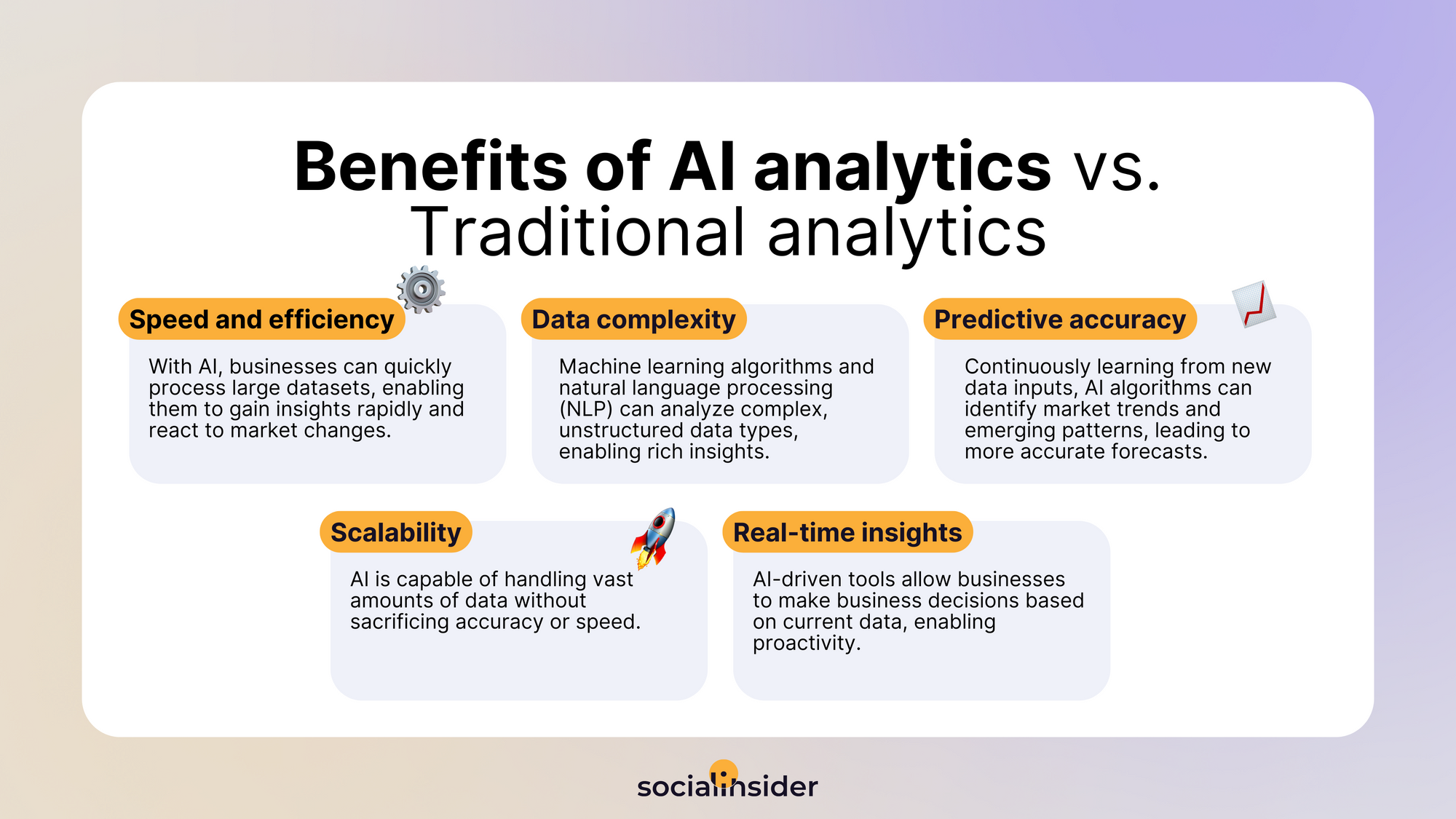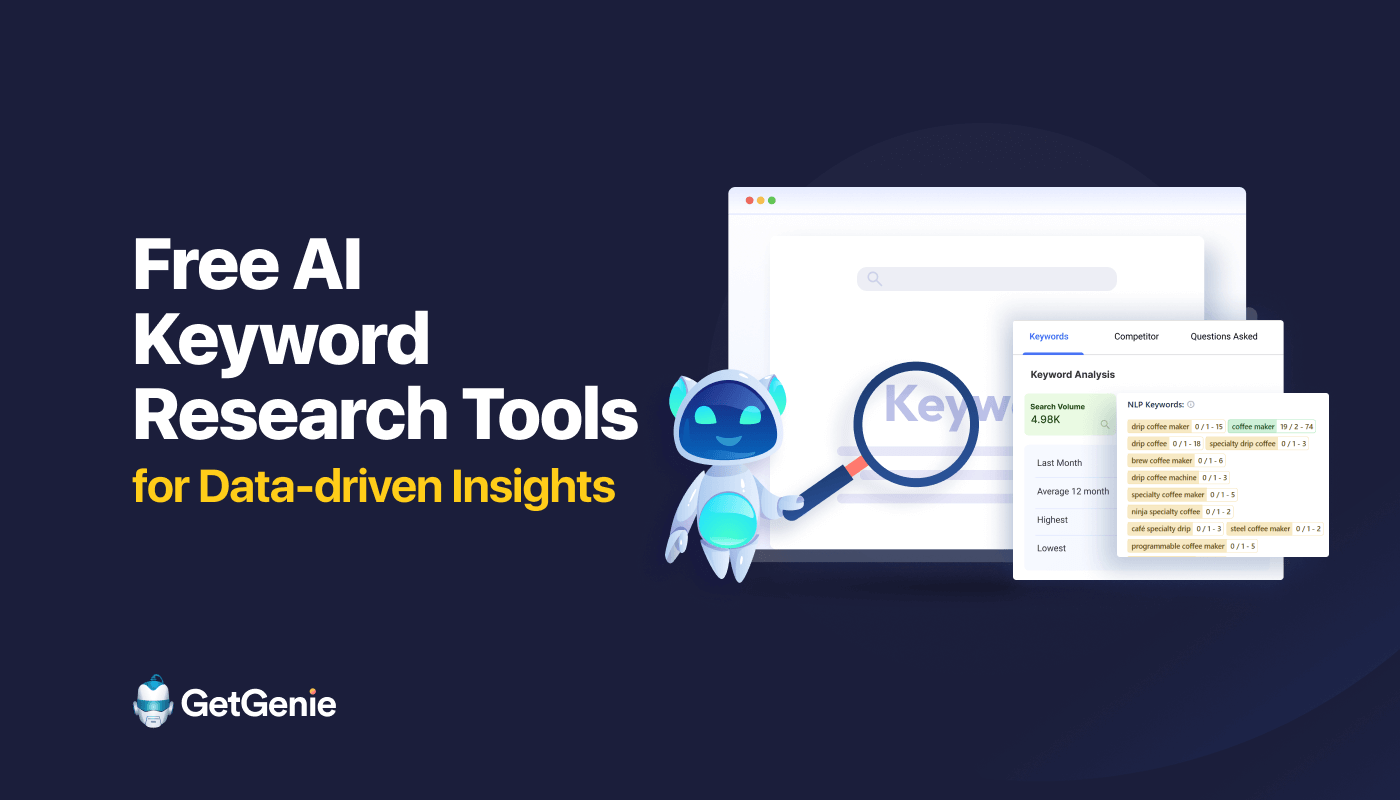Data-Driven Insights: How AI Tools Enhance Decision-Making Today. Discover how AI tools provide data-driven insights to boost your decision-making skills today. Learn to make smarter choices easily!

<<<<< Buy Now from Official offer >>>>>
What Are Data-Driven Insights?
Data-driven insights refer to information acquired by analyzing data. These insights come from data analysis, helping businesses make informed decisions. With the help of AI tools, organizations gain deeper understanding of their data. They analyze historical data patterns to predict future trends. Companies use these insights to improve performance, reduce risks, & enhance operations. It’s about using concrete data rather than intuition.
Using AI tools facilitates the extraction of actionable insights. These tools process large datasets swiftly. They identify key patterns that humans might miss. As a result, organizations can pinpoint areas for improvement & growth opportunities. This leads to strategic decisions based on factual evidence.
Data-driven insights influence both tactical & strategic decisions. They affect marketing, finance, & product development. It allows teams to focus resources effectively. On top of that, decision-makers can rely on solid data instead of guessing. In essence, data-driven insights transform raw data into valuable knowledge.
How AI Tools Improve Data Analysis
AI tools significantly enhance data analysis processes. These tools employ algorithms to sort through large amounts of data quickly. They can detect trends & anomalies faster than human analysts. This boosts efficiency in discovering important data insights.
AI can analyze text, numbers, & even images. Many AI tools integrate machine learning. This feature improves their accuracy over time. As they analyze more data, they better predict outcomes. For example, businesses can forecast sales trends or customer preferences efficiently.
Here’s a table to show how AI tools differ from traditional methods in data analysis:
| Aspect | Traditional Methods | AI Tools |
|---|---|---|
| Speed | Slower data processing | Real-time analyses |
| Volume of Data | Limited datasets | Handles massive datasets |
| Accuracy | Human error potential | High precision through algorithms |
AI tools not only speed up the analysis but also reduce human bias. People may interpret data subjectively. AI offers a neutral perspective. This leads to more objective decision-making.
Benefits of AI in Data-Driven Decision Making
AI tools provide several benefits in decision-making. They help improve efficiency, accuracy, & confidence in decisions made. Here are some key advantages:
- Faster decision-making processes.
- Greater accuracy in predictions.
- Increased ability to handle large datasets.
- Objective analyses reducing bias.
- Enhanced insights through advanced algorithms.
These benefits make AI crucial for businesses today. Traditional decision-making processes were often slower. With AI, businesses can turn data into actionable insights swiftly.
For instance, use case studies from industries such as retail. Retailers utilize AI to analyze customer purchasing behavior. This allows them to predict future trends effectively. Improved forecasts help businesses prepare stock accordingly.
AI also aids in risk assessment. Companies can evaluate risks proactively. They can prepare better strategies by using predictive analytics. Overall, the integration of AI tools makes a significant difference.
Real-World Applications of Data-Driven Insights
Many industries utilize data-driven insights through AI tools. Let’s explore a few common applications.
1. Healthcare:
Healthcare professionals leverage AI for patient data analysis. By examining historical patient records, AI can identify patterns. This helps in predicting disease outbreaks or potential health risks.
2. Finance:
Financial institutions employ AI for fraud detection. Algorithms assess transaction patterns. When anomalies occur, alerts trigger for investigations.
3. Marketing:
Marketers use AI to analyze consumer trends. They study past campaign performances to refine future strategies. Insights gained from data help personalize marketing campaigns.
4. Manufacturing:
Companies in manufacturing analyze production data. AI tools help predict equipment failures. This reduces downtime & maintenance costs.
Here is a summary table of industries benefiting from data-driven insights:
| Industry | Application |
|---|---|
| Healthcare | Patient outcome predictions |
| Finance | Fraud detection |
| Marketing | Consumer trend analysis |
| Manufacturing | Predictive maintenance |
These examples illustrate the versatility of AI tools across sectors. Businesses that adopt these methods gain a competitive edge.
Challenges in Implementing AI Tools
Despite the advantages, hurdles exist when adopting AI tools. Decision-makers must address several challenges.
– Data Quality: Reliable data is essential. Poor quality data may lead to inaccurate insights.
– Integration: Aligning AI tools with existing systems can be complicated. Companies must ensure seamless integration for effectiveness.
– Training: Employees need training to utilize AI tools efficiently. Without proper training, usage can be ineffective.
Alleviating these challenges is crucial for success. Organizations must prioritize data governance. This means ensuring data quality & accuracy.
Here are steps to address common challenges:
- Establish data validation processes.
- Provide training sessions for employees.
- Create a roadmap for integration.
- Monitor AI outcomes regularly.
Effective management of these challenges leads to enhanced decision-making capabilities.
Future Trends in AI & Data-Driven Decision Making
The landscape of data-driven insights is continuously evolving. Emerging trends indicate how AI tools will shape future decision-making.
1. Increased Automation: AI will automate more processes, particularly data collection & analysis. This will free up time for strategic tasks.
2. Enhanced Predictive Analytics: As AI evolves, so do predictive capabilities. Organizations will rely more on predictive insights for strategic decisions.
3. Focus on Ethics: Ethical AI practices will gain importance. Companies need to ensure fairness & transparency in AI operations.
4. AI & IoT Integration: The Internet of Things (IoT) will combine with AI tools. This fusion will create even deeper insights from real-time data.
This table outlines upcoming trends in AI development:
| Trend | Description |
|---|---|
| Increased Automation | Automating data processes for efficiency |
| Enhanced Predictive Analytics | Improving accuracy in forecasting |
| Focus on Ethics | Ensuring ethical AI practices |
| AI & IoT Integration | Combining AI with real-time data collection |
These trends highlight how AI continues to reshape decision-making processes.
My Experience with AI Tools for Data-Driven Insights
In my work, I’ve utilized data-driven insights to guide my decisions. Using AI tools changed how I analyze data. The speed & accuracy are remarkable. Once, I faced a challenge in forecasting sales. I used an AI tool to analyze historical sales data. The insights were insightful. They helped improve our strategy effectively. Now, I rely on AI tools regularly in my projects.
Conclusion on Data-Driven Insights in Decision-Making
AI tools play a vital role in decision-making today. They help extract detailed data-driven insights efficiently. Organizations benefit greatly from integrating these tools. They gain speed, accuracy, & the ability to make informed decisions. Despite challenges, the advantages far outweigh them. Data is invaluable & using technology to refine data analysis is crucial.
<<<<< Buy Now from Official offer >>>>>

Feature of SheetMagic: ChatGPT + Google Sheets Integration
SheetMagic: ChatGPT + Google Sheets Integration offers a unique blend of interactive AI-powered analysis & the flexibility of Google Sheets. Users can experience lifetime access to this product, which enhances data handling & analysis through smart technology. Upon the purchase of SheetMagic, users must redeem their code(s) within 60 days. This ensures they can utilize the full potential of the integration from day one.
This tool allows users to connect ChatGPT with Google Sheets, enabling seamless data manipulation & enhanced analysis. Here are the high-level features users can expect:
- Automated data entry & suggestions based on past inputs.
- Advanced data analysis tools powered by AI.
- Real-time collaboration features for team efficiency.
- Customizable templates for repetitive tasks.
- Multiple language support for global teams.
And another thing, users on the Single User License Plan can enjoy all future updates, ensuring that they stay current with the latest features. Users can stack up to four codes, enabling scalability to suit various user needs & demands.
Challenges of SheetMagic: ChatGPT + Google Sheets Integration
Another common issue involves compatibility. Users experience troubles when trying to work with third-party plugins within Google Sheets, leading to a frustrating user experience. These compatibility issues can hinder productivity & also create confusion among team members who rely on various tools.
Lastly, there is a potential learning curve associated with maximizing the tool’s functionality. Many users find themselves needing extra time to become proficient in its features. Training resources can help mitigate this challenge, but some users still report a lack of straightforward guides for advanced functionalities.
Price of SheetMagic: ChatGPT + Google Sheets Integration
When evaluating SheetMagic: ChatGPT + Google Sheets Integration, pricing is essential. The product offers different plans that cater to various user needs. Below is a breakdown of the pricing tiers:
| Plan | Price |
|---|---|
| Plan 1 | $69 |
| Plan 2 | $138 |
| Plan 3 | $207 |
This tiered pricing structure allows flexibility for users, providing options based on individual or organizational needs. Each plan includes access to essential features while unlocking additional capabilities as users scale up their plans.
Limitations of SheetMagic: ChatGPT + Google Sheets Integration
And another thing, the user experience can vary. Some users report a less intuitive interface that does not align well with their workflow preferences. This leads to frustration, especially for those who expect seamless transitions between data entries & analysis.
Finally, various users have mentioned inadequate support resources. They find themselves in need of more tutorials or customer support channels when facing specific issues. A stronger support system would significantly improve user satisfaction & engagement.
Case Studies
Case studies provide insight into the real-world impact of SheetMagic: ChatGPT + Google Sheets Integration. Here are a few notable examples:
- A marketing team utilized SheetMagic to streamline their campaign analysis. They could input data directly into Google Sheets & receive AI-driven insights instantly, allowing them to adjust strategies in real-time.
- An e-commerce business integrated SheetMagic to handle inventory management. This led to automated inventory updates & insights on stock levels, improving their overall efficiency.
- A finance team harnessed the integration to create automated reports. The team saved hours of manual entry by using conversational AI to analyze & generate their financial summaries.
- A non-profit organization utilized the tool to manage donor databases, significantly enhancing their engagement strategies through data-driven insights.
- A product team used SheetMagic for innovative product development analytics, allowing them to quickly pivot based on user feedback & market trends.
The success in these cases illustrates how teams overcame challenges & strategically utilized the integration to enhance their decision-making process.
Recommendations for SheetMagic: ChatGPT + Google Sheets Integration
Users seeking to maximize their experience with SheetMagic: ChatGPT + Google Sheets Integration can employ several strategies. First, users should consider taking full advantage of available resources. Engaging with online communities & forums can provide insights from other users & experts who may offer tips for effective use.
Second, leveraging the automation capabilities of SheetMagic can significantly reduce workload. By setting up triggers & automated input methods, users can free up time for more strategic tasks.
Lastly, integrating complementary tools can enhance functionality. Users accessing data from different sources can benefit from additional analytics or project management tools that work well with Google Sheets. Making these connections can lead to even more powerful decision-making capabilities, providing a holistic view of data.
Key Features of AI Tools for Decision-Making
- Real-time data analysis to support immediate decisions.
- Predictive analytics to forecast trends & outcomes.
- Visualization options for better understanding of data.
- Task automation to enhance productivity.
- Integrations with multiple platforms for broader data access.
Best Practices for Using AI in Decision-Making
- Identify key metrics you wish to analyze.
- Regularly update data to ensure accuracy.
- Encourage team collaboration on data projects.
- Utilize visual aids to communicate findings.
- Focus on actionable insights rather than overwhelming data.
Common Use Cases for Data-Driven Insights
- Market research & analysis for product launches.
- Sales forecasting to refine inventory management.
- Customer segmentation for personalized marketing.
- Risk assessment in finance & investment.
- Performance tracking for project management.

What are data-driven insights?
Data-driven insights refer to findings & conclusions drawn from analyzing data. These insights help organizations make informed decisions based on patterns & trends identified through data analysis.
How do AI tools contribute to data-driven insights?
AI tools analyze large datasets efficiently, identifying trends & patterns that may not be visible to humans. They can process data at a speed & scale that enhances the overall decision-making process.
What types of AI tools are used for enhancing decision-making?
Common AI tools include machine learning algorithms, predictive analytics software, & natural language processing systems. These tools help in processing data & generating insights that support strategic choices.
Can AI tools replace human decision-making?
While AI tools can provide valuable insights & suggestions, human oversight is essential. Critical thinking & contextual understanding are necessary for making nuanced decisions that consider various factors beyond data.
What industries benefit from data-driven insights through AI?
Multiple industries, including finance, healthcare, retail, & marketing, benefit from data-driven insights. Each sector utilizes AI tools to refine strategies, optimize operations, & enhance customer experiences.
How can businesses implement AI tools for decision-making?
Businesses can start by identifying specific needs, selecting appropriate AI tools, & integrating them with existing data systems. Training staff on how to interpret & act on insights is also critical for successful implementation.
What are some challenges in using AI for data-driven insights?
Challenges include data quality issues, integration difficulties, & resistance to adopting new technologies. Ensuring data privacy & compliance with regulations also poses challenges for organizations using AI tools.
How can data privacy be maintained while using AI tools?
Maintaining data privacy involves implementing strong security measures, anonymizing sensitive information, & ensuring compliance with data protection regulations. Transparency with stakeholders about data usage is also vital.
What role does data quality play in decision-making?
Data quality is crucial, as high-quality data leads to accurate insights. Clean, reliable data ensures that decisions are based on sound evidence rather than erroneous or misleading information.
How do predictive analytics work in decision-making?
Predictive analytics uses statistical algorithms & machine learning techniques to analyze historical data & forecast future outcomes. By identifying patterns, organizations can make proactive decisions based on predicted trends.
What is the future of AI in decision-making?
The future of AI in decision-making involves greater advancements in machine learning, enhanced personalization, & improved collaboration between humans & AI systems, leading to more effective & efficient decision-making processes.
How can organizations measure the effectiveness of AI-driven insights?
Organizations can measure effectiveness by tracking key performance indicators (KPIs), evaluating the impact on decision outcomes, & gathering feedback from stakeholders regarding the relevance & usability of the insights provided.
What skills are needed to interpret AI-driven data insights?
Skills required include data analysis, critical thinking, familiarity with AI tools, & domain knowledge relevant to the specific industry. These skills enable individuals to draw actionable conclusions from data outputs.
Are AI tools user-friendly for non-technical staff?
Many modern AI tools are designed with user-friendly interfaces, making them accessible to non-technical staff. Training & support also play a significant role in enabling users to leverage AI effectively.
What is the significance of real-time data in decision-making?
Real-time data provides insights into current trends & behaviors, allowing organizations to make timely decisions. This immediacy can lead to improved responsiveness & the ability to seize opportunities as they arise.
<<<<< Buy Now from Official offer >>>>>
Conclusion
In today’s fast-paced world, Data-Driven Insights play a crucial role in helping businesses thrive. By using AI tools, leaders can easily analyze large amounts of information, making smarter choices. These tools take the guesswork out of decision-making, allowing teams to focus on what truly matters. As we’ve seen, the advantages of harnessing Data-Driven Insights are undeniable. With AI tools by our side, we can navigate challenges & seize opportunities more effectively. Embracing this technology isn’t just an option; it’s a key step towards a successful future in decision-making. Let’s keep moving forward together!
<<<<< Buy Now from Official offer >>>>>

Leave a Reply